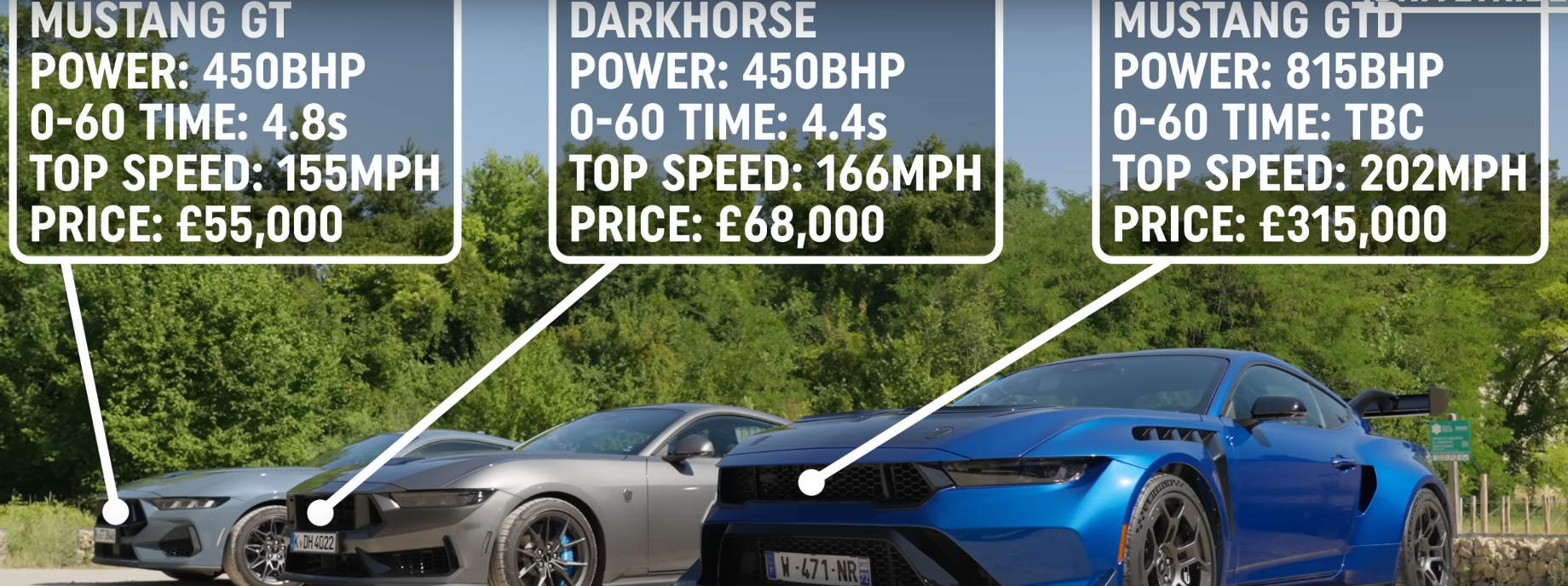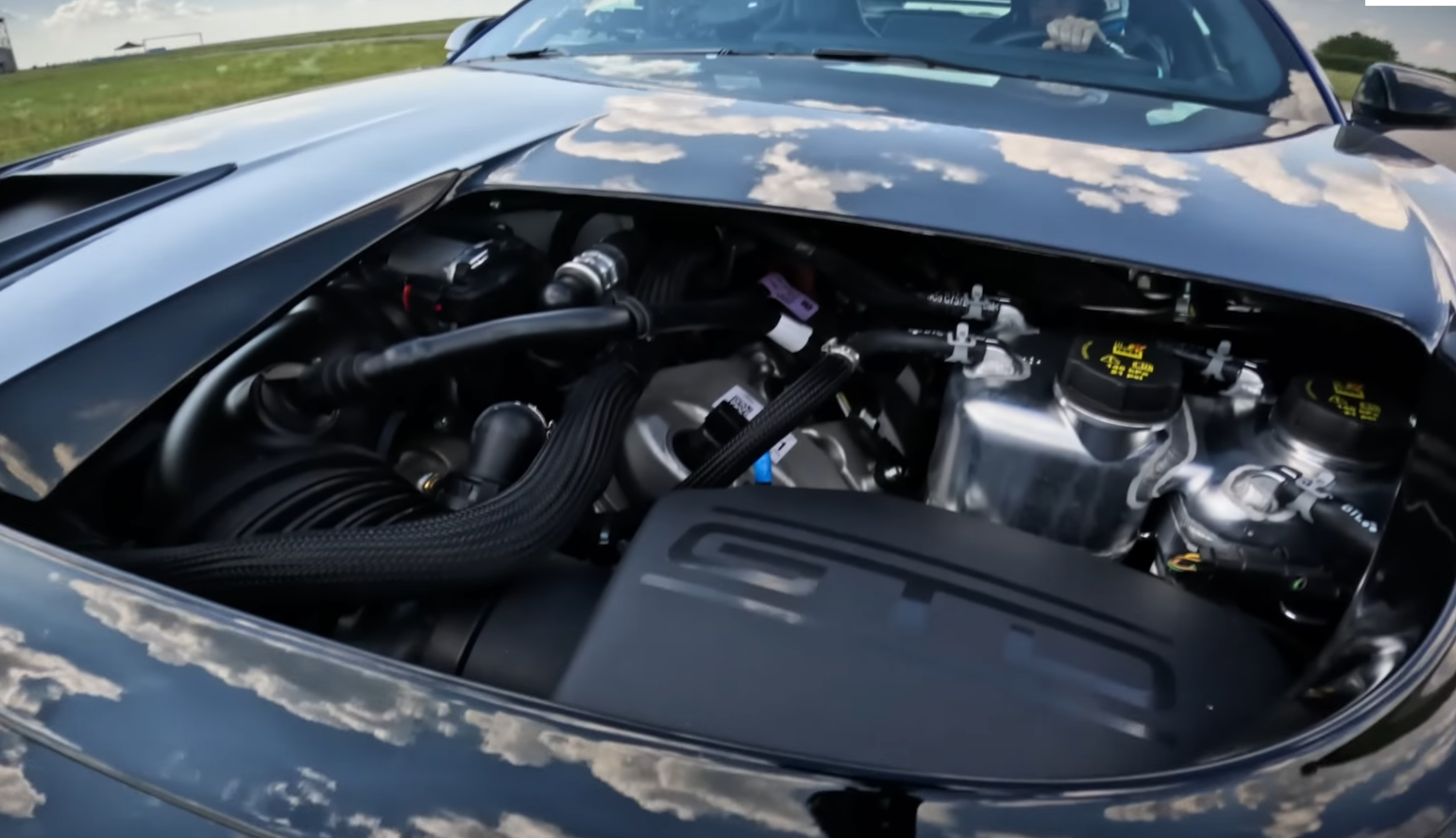Driving three new V8 Mustangs across Western France is more than just a delivery job. Each car brings its own character, from the accessible GT to the extreme GTD, a machine built with race car engineering but made legal for the road. The journey highlights not only the differences between these models but also the culture and history tied to the Mustang name.
Along the way, the trip connects modern performance with the roots of motorsport in France. Visiting historic circuits shows how racing shaped car culture and why these roads remain important to enthusiasts today. The Mustangs serve as a link between past and present, proving that performance cars are meant to be driven, not stored away.
Key Takeaways
- The trip showcases three versions of a modern performance car.
- Historic racing sites add context to the driving experience.
- The journey reflects how car culture blends heritage with modern engineering.
Meet the V8 Mustangs
A Look at the Three Versions
The group received three new V8 Mustangs to drive across Western France. Each one represented a different place in the lineup:
| Model | Engine | Power | Notes |
|---|---|---|---|
| Mustang GT | 5.0L Coyote V8 | 450 hp | Considered the entry point, priced around £55,000. |
| Mustang Dark Horse | 5.0L V8 (enhanced) | Higher output than GT | Positioned as the step between GT and GTD. |
| Mustang GTD | 5.2L Supercharged Predator V8 | 815 hp | Built from a race car with advanced suspension and unique tires. |
The GTD stood out with its rear transaxle, carbon fiber driveshaft, and suspension visible through the rear mirror. The GT offered a more traditional four-seat setup, while the Dark Horse sat between them as the sharper road-focused option.
First Reactions and Role Assignments
Each driver claimed a car for the trip. One took the GT and compared it to rivals like the BMW M2. Another chose the Dark Horse, already familiar with it from a prior drive. The GTD went to the most eager driver, who described it as a rare chance to experience a race car adapted for the road.
Temperatures hit 38°C during the drive, adding to the challenge. The group treated the delivery like real work, but also made time to explore an abandoned French racetrack along the route. The lineup of Mustangs drew attention wherever they stopped, with each driver insisting theirs looked the best.
Mustang GTD: Race Car for the Road
Design and Powertrain
The Mustang GTD comes from a different approach than most performance cars. Instead of toning down a race car for the street, engineers removed restrictions and built a machine without compromise.
It uses a 5.2-liter supercharged Predator V8 producing 815 horsepower. Power goes through a rear-mounted transaxle gearbox with a carbon fiber driveshaft, giving the car near-perfect 50/50 weight balance.
| Key Specs | Details |
|---|---|
| Engine | 5.2L Supercharged V8 |
| Horsepower | 815 hp |
| Drivetrain | Rear-wheel drive |
| Weight Balance | 50/50 |
| Top Speed | ~202 mph |
Standout Elements
Inside, the GTD replaces rear seats with exposed suspension components visible through the mirror, showing how the car constantly adjusts to keep maximum tire grip.
The tires themselves are specially developed for this model, wider than those found on any previous Mustang. Even the front tires are larger than the rears of older high-performance versions.
Other details include:
- Active aerodynamics for stability at high speeds
- Carbon fiber construction for reduced weight
- Track-focused suspension designed for precision
Behind the Wheel
Driving the GTD feels unlike a standard Mustang. Instead of a family coupe, it delivers the raw focus of a race car adapted for public roads. The suspension reacts instantly, the tires grip with unusual force, and the engine pushes with relentless power.
The car is not meant to sit in a showroom. It was built to be driven hard, whether on open roads or closed circuits, always reminding the driver of its racing origins.
Mustang GT: Everyday Performance
5.0L V8 Key Features
The Mustang GT carries a 5.0-liter Coyote V8 that produces about 450 horsepower. Power goes to the rear wheels, keeping the car true to its muscle car roots. Even though it is the most affordable of the new V8 Mustangs, it still offers strong performance and a classic sound that stands out.
Quick Specs:
| Engine | Power | Drive | Price (approx.) |
|---|---|---|---|
| 5.0L Coyote V8 | 450 hp | Rear-wheel drive | £55,000 |
Rivals and Price Point
At around £55,000, the GT undercuts many cars in its class. The closest rival is the BMW M2, which makes slightly more power at 475 hp but costs more. In terms of layout and performance, the Mustang GT sits in a unique spot with fewer direct competitors, especially at its price.
Comparison Snapshot:
- Mustang GT: 450 hp, V8, ~£55k
- BMW M2: 475 hp, inline-six, higher cost
Driving Feel on the Road
Behind the wheel, the GT delivers a cool and confident presence. The V8 soundtrack adds character, and the car feels at home on open roads. During the trip through France, the GT proved enjoyable not only for its power but also for the sense of style it brings to everyday driving.
Drivers noted that the GT feels like the right car to explore historic racing roads, blending modern performance with a touch of classic motoring spirit.
Journey Across Western France
Driving the Route
They set off across Western France with three new Mustangs: the standard GT, the Dark Horse, and the extreme GTD. Each car had its own character, from the 5.0L Coyote V8 in the GT to the 815-horsepower Predator V8 in the GTD. Along the way, they stopped at an abandoned circuit from 1926, its faded signs and empty grandstands still standing.
Car Lineup:
| Model | Engine | Power | Notable Feature |
|---|---|---|---|
| GT | 5.0L Coyote V8 | 450 hp | Everyday usability |
| Dark Horse | 5.0L V8 (upgraded) | Higher output | Track-focused setup |
| GTD | 5.2L Supercharged Predator V8 | 815 hp | Race-derived suspension |
Group Interaction on the Road
Each driver claimed pride in their car, with playful arguments over which Mustang looked and sounded best. They compared the lineup to Porsche’s range, joking about the GTD being the wildest of the group. Stops along the way turned into photo opportunities, tire checks, and lighthearted banter.
Notable moments:
- Jokes about the GTD’s name being shared with a diesel Golf
- Friendly teasing about impatience to drive the fastest model
- Shared excitement at exploring the old French racetrack
Obstacles and Heat
The trip took place during the hottest day of the year, with temperatures reaching 38°C. The heat made driving uncomfortable, even shrinking one driver’s trousers. Despite the conditions, they pressed on, noting how the GTD’s unique suspension and custom tires worked to keep grip steady on the road.
Key difficulties faced:
- Extreme heat affecting comfort
- Long drives in powerful but demanding cars
- Temptation to push speeds on historic roads despite police risk
Exploring Historic French Racetracks
Finding the Forgotten Track
Driving through the countryside, they came across an old circuit hidden in plain sight. The remains of the grandstand, painted signs, and weathered track edges still stood. It felt like stepping back into another era, where racing once filled the air with sound and speed.
Past and Importance
The circuit first opened in 1926 and was known for its long straights linked by sharp corners. By the 1970s, cars were averaging 146 mph around the track. Safety concerns eventually forced its closure, as houses and trees lined the course. Efforts were even made to cut trees and remove buildings, but the risks remained too high.
| Year Opened | Layout Style | Closed | Average Lap Speed (1970s) |
|---|---|---|---|
| 1926 | Straights + Corners | 1970s | 146 mph |
Setting and Details
The atmosphere carried a mix of silence and history. Faded hand-painted signs and old structures gave the place character. Modern cars passed nearby, but the track itself felt frozen in time. The group paused to explore, take photos, and line up their Mustangs, appreciating how the past and present met on this forgotten stretch of French racing history.
Thoughts on Mustang Identity
Roots and Progress
The Mustang has always carried a working‑class image, but it has steadily grown into something more advanced. The seventh generation shows how far it has come, with models ranging from the 5.0L V8 GT to the track‑ready GTD. Each version reflects a balance between tradition and engineering progress.
Key traits across models:
- Rear‑wheel drive focus
- Strong V8 engines
- Clear link to racing heritage
Old School vs New Age
Classic Mustangs gave drivers a raw, simple experience, while today’s versions add advanced technology and performance engineering. For example, the GT offers power at a price that undercuts many rivals, while the GTD takes a racing platform and adapts it for both track and road.
| Model | Engine | Power | Character |
|---|---|---|---|
| GT | 5.0L Coyote V8 | ~450 hp | Everyday muscle car feel |
| Dark Horse | 5.0L V8 (tuned) | Higher output | Sharper and more aggressive |
| GTD | 5.2L Supercharged V8 | 815 hp | Race car for the road |
The Driving Experience
Behind the wheel, the Mustang emphasizes connection and excitement. The GTD’s suspension allows the driver to see the mechanics at work through the mirror, while its custom tires maximize grip. Even the more affordable GT delivers a sense of pride and presence on the road.
Driving impressions:
- Strong sound and feel from the V8s
- Unique suspension design in the GTD
- Cars meant to be used, not stored away
The culture around the Mustang thrives on this mix of heritage, performance, and the simple joy of driving.








